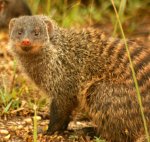 A Banded Mongoose (Mungos mungo) lives in parts of Africa, and its main distribution is at the Sahara's south parts. Outside this main distribution, it could be located from Gambia to Ethiopia. Banded mongooses could survive on many habitats, such as rocky ground, woods and grasslands. One habitat they could not survive on however, are the deserts.
A Banded Mongoose (Mungos mungo) lives in parts of Africa, and its main distribution is at the Sahara's south parts. Outside this main distribution, it could be located from Gambia to Ethiopia. Banded mongooses could survive on many habitats, such as rocky ground, woods and grasslands. One habitat they could not survive on however, are the deserts.It is basically considered as small, in the breeds of mongoose. A Banded Mongoose could be recognized apart from its relatives by the set of black marks along the back, midback and tail's area. Their cheek teeth have rounded cusps, and a Banded Mongoose's muzzle is quite pointed. Just like us, it has 5 digits on the foot (front) but at the hind foot, it has four (unlike us). These hind feet have claws.
The litter size varies, anything from 2 to 6, and these young come into the world via grassy chambers, which are holes on the soil, or even termite homes. A young would be fed by a lactating female, not necessarily the m
other. If the pack leaves for preying adventures, on the average, a female for 8 newborns would be left behind. The newborns would start leaving the nesting ground at around a month old.
A Banded Mongoose is diurnal, and definitely not a solitary creature. They exist in packs that number from ten to twenty.
The reproduction within a group is usually synchronized, and as a result, many females would give birth WITHIN the same week, just few days apart.
* Author: TKnoxB]
* Source
* Licensed under Creative Commons Attribution 2.0 License
Which zoos have them?
Smithsonian National Zoological Park (United States)The Banded mongoose is listed as Least Concern (LR/lc), lowest risk. Does not qualify for a more at risk category. Widespread and abundant taxa are included in this category, on the IUCN Red List of Threatened Species
Namings for the banded mongoose
A banded mongoose group is called a 'mongeese or mongaggle'.Countries
Angola, Botswana, Burundi, Cameroon, Central African Republic, Chad, Congo, Democratic Republic of the, Ethiopia, GuineaBissau, Kenya, Malawi, Mozambique, Namibia, Niger, Nigeria, Rwanda, Senegal, Somalia, South Africa, Sudan, Tanzania, Uganda, Zambia and ZimbabweSome facts about the
Banded mongoose
Adult weight : 1.332 kg (2.9304 lbs)
Maximum longevity : 17 years
Female maturity :289 days
Gestation : 60 days
Litter size : 3
Litters per year : 2
Weight at birth : 0.039 kg (0.0858 lbs)

Custom Search